|
|
 |
|
Piazza Navona: Plaza of Roma |
|
written
by Kaia Chessen / 07.12.2004 |
|
|
| |
Site Location |
| |
| |
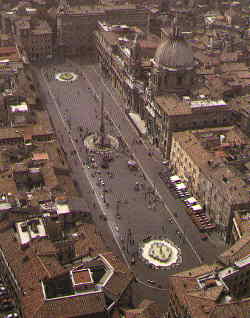
|
|
| C:\Documents and Settings\Bruce\My Documents\My Pictures\navona.jpg |
|
| |
|
The Piazza Navona, an outdoor urban center surrounded by old buildings, restaurants, and markets and dotted with three fountains and a church, resides in Roma.
|
| |
|
| |
|
| |
Site History |
| |
| |
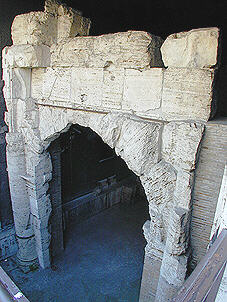
|
|
| C:\Documents and Settings\Bruce\My Documents\My Pictures\nav-arch-domitian-da.jpg |
|
| |
|
| |
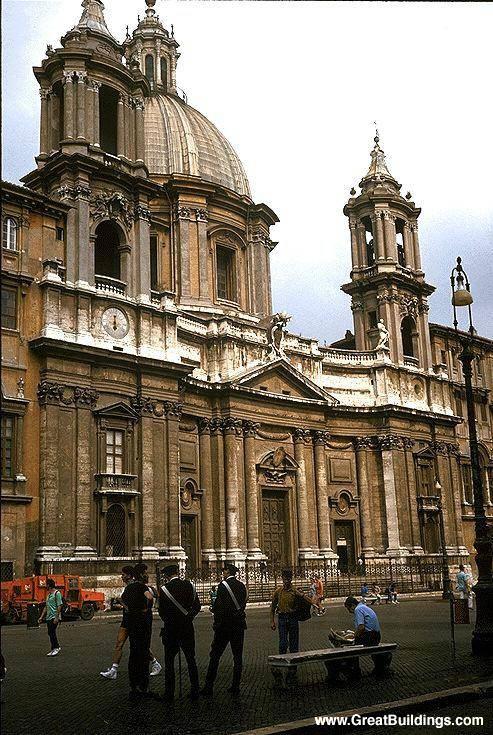
|
|
| C:\Documents and Settings\Bruce\My Documents\My Pictures\piazza navona church facade.jpg |
|
| |
|
In ancient times, the site of the Piazza Novana was a circus called Circus Domitianus and the stadium from which it went on was Domitian's Stadium. The piazza took on the elongated shape of the stadium and now sits on its ruins. The piazza itself is the site within the stadium that races would be held as part of the Agonal games. The name Navona is derived from this as "Agonal" changed to "in Agone" to "n'Agone" to "Navone" to "Navona". There is still access to the remains underneath the piazza and tours are held daily.
The church in the center of the piazza, the church of Sant'Agnese ("uhn-Yeh-seh") was built in memory of a 12-year-old Agnes (a Christian) who refused to marry a pagan. Because of her disobedience, she was stripped naked on this site, although miraculously covered by a sudden growth of her hair, and martyred. The church was commissioned by Pope Innocent X in 1652 and taken over by Francesco Borromini who finished its dome, twin belltowers, and concave facade.
|
| |
|
| |
|
| |
Elements of Interest |
| |
| |

|
|
| C:\Documents and Settings\Bruce\My Documents\My Pictures\nav-pasquino-da-m10.jpg |
|
| |
|
| |
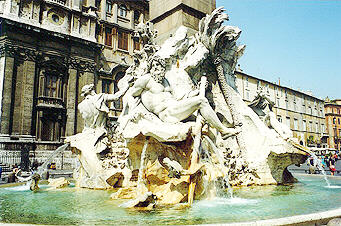
|
|
| C:\Documents and Settings\Bruce\My Documents\My Pictures\navona fountain.jpg |
|
| |
|
There are three fountains within the piazza. Towards the center is Bernini's La Fontana dei Fiumi (fountain of rivers) which he constructed in 1651. The center statue supports a giant obelisk which represents an ancient Roman imitation of an Egyptian monument. Four figures surround the obelisk, each representing one of the rivers of the four corners of the world: the Nile, the Danube, the Ganges, and the Rio della Plata. The figure facing Borromini's church is said to be covering its face since the Bernini and Borromini were said to be rivals. However, this rumor cannot be true since the church was constructed after the fountain.
To the Northern end of the piazza is the fontana di Nettuno (Neptune). It's basin was constructed by Giacomo della Porta in 1576 and the statues were built more recently by Calderari. To the Southern end is the fontana del Moro (Moor) also by Bernini. This fountain depicts a Moor battling a dolphin.
If one leaves the piazza from the west, he or she will find him or herself in another piazza which is home to Pasquino, a "talking" statue. When it was not safe to talk openly, political commentators would sneak to the statue in the night and attach satirical messages. The contents of the messages would be spread around town by mouth in the morning.
|
| |
|
| |
|
| |
Analyze Image |
| |
| |
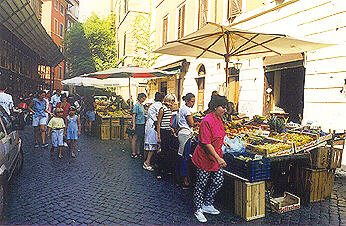
|
|
| C:\Documents and Settings\Bruce\My Documents\My Pictures\nav-market-pace-da-m10.jpg |
|
| |
|
One of the many attractions of the Piazza Navona is its open air markets. As in this photo, travelers and locals stroll down cobblestone walk-ways and alleys surrounding the piazza. It is apparently very warm and bright, requiring large umbrellas and overhangs to block the sun. As customers browse over the vendors' selections of produce and other goods, they pass by 17th century buildings (signifying antiquity) on one side and parked cars (signifying modernity) on the other.
The picture shows a close-up scene of a usual activity at the piazza, but leaves out almost all of the beautiful sculpture, architecture, and history of which it is made up. From looking at this picture, one cannot picture the sheer size of the piazza or all the amazing buildings, fountains, or churches surrounding it. There also many other occurances daily. There are artists painting tourists' portraits, open air cafes, restaurants, night clubs, famous wine shops, musicians, and sometimes even mimes.
|
| |
|
| |
|
| |
Site Questions |
| |
What kind of exhibits were featured at the Circus Domitianus on whose remains the piazza is built? Were circuses condemned for being Pagan?
What is the length (in feet, not meters) of the piazza?
|
| |
|
| |
|
|
 |
|






